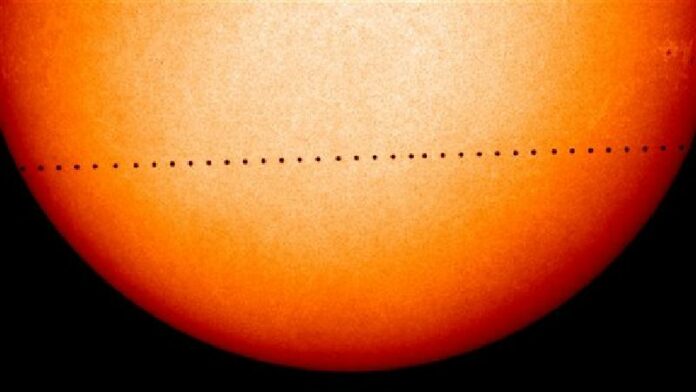
CAPE CANAVERAL, Fla. — Earthlings are in for a treat Monday as Mercury makes a relatively rare transit of the sun
The solar system’s smallest, innermost planet will resemble a black round dot as it passes in front of our big, bright star. The last time Mercury crossed directly between the Earth and sun was in 2006, and it won’t happen again until 2019 — and then, until 2032. NASA says the event occurs only about 13 times a century.
Louis Mayo, program manager at NASA’s Goddard Space Flight Center in Greenbelt, Maryland, considers it “a big deal.”
“Astronomers get excited when any two things come close to each other in the heavens,” Mayo said in a statement.
The eastern U.S. and Canada will see the entire 7 1/2-hour transit, as will most of South America, western Europe and westernmost Africa. In the western portion of North America, stargazers can join in midway, at sunrise, while those in eastern Europe, central Asia, the Middle East and most of Africa will have to call it quits early when the sun goes down. Australia will have to sit this one out altogether.
In Thailand it will be visible from 6:10 pm to 6:36pm according to the Thai Astronomical Society.
Forget eclipse glasses. At barely 3,000 miles (around 4,800 km) across, Mercury would be too small to spot. You’ll need binoculars or telescopes equipped with proper solar filters to protect your eyes.
Look for Mercury south of the sun’s equator. The planet might appear as though it’s hardly moving, but in reality it will be zooming past the sun at nearly 170,000 kmph.
Three spacecraft will observe the transit, so if you can’t catch it with your own eyes, check out the space agency online. NASA promises images close to real time from its Solar Dynamic Observatory.
Astronomers have been observing Mercury transits since the 1600s. Monday’s occurrence will allow scientists to fine-tune instruments aboard solar observatories like SDO and learn even more about the sun.
Story: Marcia Dunn / Associated Press

















































